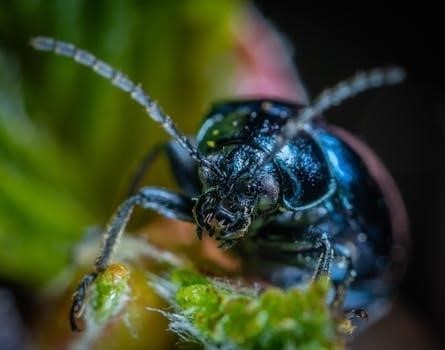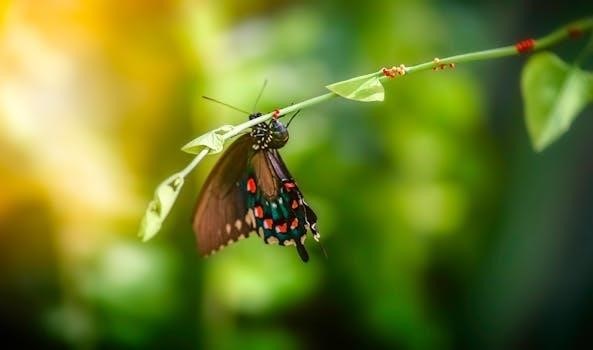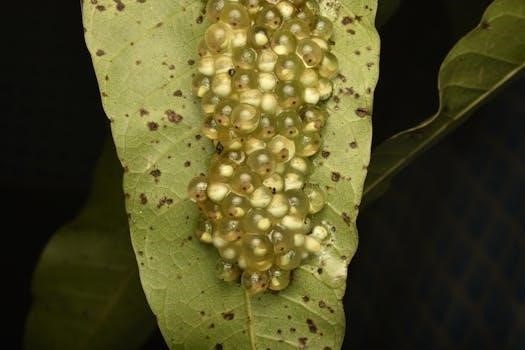Insect Egg Identification Guide⁚ A Visual Approach
This guide provides a visual journey into the realm of insect eggs,
offering pictures to aid identification of these often overlooked,
yet crucial stages of an insect’s life.
Insect eggs represent a hidden world, often unseen yet teeming with
potential. These tiny vessels hold the key to future generations of
insects, both beneficial and detrimental. Identifying insect eggs
can provide insights into potential infestations, predict pest
outbreaks, and allow for timely intervention.
From the small white eggs hidden in the soil to the bug eggs carefully
placed on a leaf, insects have evolved diverse strategies for
protecting their offspring. This guide aims to unravel some mysteries
surrounding insect egg identification, offering a visual approach to
distinguish between different species.
Recognizing these eggs is the first step in integrated pest
management. By understanding the characteristics of insect eggs,
homeowners and gardeners can make informed decisions about pest
control, promoting a healthy ecosystem and preventing extensive
damage.
Insect eggs come in various shapes, sizes, and colors, reflecting the
diversity of the insect world. This introduction will highlight the
importance of identifying these eggs and understanding their role in
the life cycle of insects.

Understanding Insect Egg Morphology
Insect egg morphology encompasses the study of their form and
structure. Variations in shape, size, color, and texture provide
clues for identification and understanding their evolutionary
adaptations.
Egg Shape and Size Variations
Insect eggs exhibit remarkable diversity in shape and size. Their
dimensions often relate to the insect’s overall size and its
oviposition strategy. Shapes range from spherical to oval, cylindrical,
and even flattened or disc-like forms. Some are minute, barely visible
to the naked eye, while others are significantly larger.
Egg size can also indicate the amount of nutrients provisioned for the
developing embryo. Larger eggs often contain more yolk, supporting
longer development times or larger initial larval stages. The shape can
further influence environmental resilience, affecting resistance to
desiccation or predation.
Observing egg shape and size, along with other characteristics, is a
valuable step in insect egg identification. Considering these physical
attributes alongside the plant or location where the eggs are found is
crucial for accurate identification. It’s a puzzle where every detail
matters.
Color and Texture as Identifiers
Color and texture provide key clues in insect egg identification.
Egg colors span a wide spectrum, from translucent whites and yellows to
greens, browns, and even blacks. Some eggs exhibit iridescent or
metallic sheens. Color can be influenced by pigments within the eggshell
or by the contents of the developing embryo.
Texture also varies considerably. Some eggs are smooth and glossy, while
others are rough, ridged, or covered in intricate patterns. The surface
may be adorned with tiny spines or hairs. The texture can serve to
protect the egg from predators or environmental stressors.
Changes in color can also indicate the egg’s age or stage of
development. Combining these observations with shape, size, and
location will increase the accuracy of insect egg identification.
Therefore, careful observation of both color and texture is essential
for distinguishing between different species’ eggs, as these
characteristics offer invaluable insight.
Oviposition Sites⁚ Clues to Identification
The location where an insect lays its eggs, known as the oviposition
site, offers significant clues for identification. Insects carefully
select these sites to maximize their offspring’s survival.
Some species deposit eggs on specific host plants, ensuring a readily
available food source for the emerging larvae. Others may choose
protected locations like undersides of leaves, crevices in bark, or
within soil; Aquatic insects lay eggs in or near water sources.
Observing the placement of eggs – whether they are laid singly, in
clusters, or in organized patterns – provides further insight.
Cockroach eggs are often found in dark, hidden areas. Bed bug eggs are
often found in clusters in cracks. Paying attention to the surrounding
environment and the resources available at the oviposition site
contributes to narrowing down potential insect species.
By analyzing these clues, you can significantly improve your ability to
identify insect eggs accurately.

Common Insect Eggs⁚ A Visual Guide
Explore a visual guide to identifying common insect eggs, focusing on
distinctive characteristics. This section showcases various insect egg
types with images to assist in recognition.
Butterfly and Moth Eggs⁚ Characteristics and Images
Butterfly and moth eggs are typically small, exhibiting diverse shapes
from round to oval. These eggs are frequently laid in clusters on the
undersides of leaves or stems, strategically placed near food sources
for the emerging larvae. Their colors vary widely, encompassing white,
yellow, green, and even iridescent hues.
Visual identification is key, as different species showcase unique
patterns and textures on their egg surfaces. Close examination of
these features, coupled with knowledge of the host plant, can greatly
aid in pinpointing the specific butterfly or moth species.
Images of various butterfly and moth eggs will be presented,
highlighting their distinct characteristics, size variations, and common
oviposition sites. Note that these images are for illustrative
purposes, and professional assistance may be required for definitive
identification. Recognizing these eggs early can assist in managing
garden pests.
Aphid Eggs⁚ Identification and Location
Aphid eggs are often minute and can be quite challenging to spot with
the naked eye. They typically appear as small, oval-shaped structures,
frequently laid in clusters or rows on the stems and undersides of
plant leaves. Their color can range from yellow to green to black,
depending on the aphid species and the stage of development.
Identifying aphid eggs requires a close inspection of susceptible
plants, particularly during the cooler months when aphids enter their
overwintering phase. Knowing the specific host plants favored by
different aphid species can significantly narrow down the
identification process.
Aphid eggs are commonly found in hidden areas of the plant. Images of
aphid eggs, showcasing their subtle features, are available. Remember
that accurate identification is crucial for implementing effective pest
management strategies, distinguishing them from beneficial insects.
Early detection and appropriate action can prevent aphid infestations,
protecting gardens.
Cockroach Eggs⁚ Appearance and Habitat
Cockroach eggs are not laid individually but rather encased in an
ootheca, a protective egg case. These oothecae vary in size and color
depending on the cockroach species, ranging from dark brown to reddish-brown
or even black. German cockroach oothecae, for example, are light brown and
elongated. They are often dropped or attached in dark, hidden areas.
Identifying cockroach oothecae is crucial for early detection and
prevention of infestations. Look for them in warm, humid environments
such as kitchens, bathrooms, and basements. Common hiding spots include
underneath appliances, behind furniture, and inside cracks and crevices.
Regularly inspect these areas, paying close attention to dark, undisturbed
corners.
Pictures of different cockroach oothecae can aid in accurate
identification. Knowing the specific type of cockroach infesting a
property is essential for implementing effective control measures. Prompt
action, including sanitation and professional pest control, can help
eliminate cockroach infestations.
Bed Bug Eggs⁚ Recognizing Infestations
Bed bug eggs are tiny, typically white or translucent, and oval-shaped,
resembling small grains of rice. They are about 1mm in length, making them
difficult to spot with the naked eye. These eggs are often found in
clusters, securely attached to surfaces in close proximity to where bed
bugs feed.
Recognizing bed bug eggs is crucial for early detection of infestations.
Inspect mattresses, bed frames, headboards, and nearby furniture for these
tiny eggs. Pay close attention to seams, crevices, and cracks where bed
bugs like to hide. Using a flashlight and magnifying glass can aid in
identification.
Pictures of bed bug eggs can provide a visual reference for identification.
However, due to their small size, it’s important to consider other signs of
bed bug activity, such as live bed bugs, shed skins, and blood stains on
bedding. If you suspect a bed bug infestation, seek professional pest
control services for proper identification and treatment.

Distinguishing Beneficial vs. Pest Insect Eggs
Telling apart beneficial insect eggs from pest eggs is key. This prevents
harming helpful bugs while targeting harmful ones, crucial for garden
health and balance.
Identifying Beneficial Insect Eggs (e.g., Ladybugs)
Recognizing the eggs of beneficial insects is vital for promoting a healthy
garden ecosystem. Ladybug eggs, for instance, are typically small, oval,
and yellowish-orange, often found in clusters on leaves near aphid colonies,
their soon-to-be food source. These eggs hatch into larvae that are voracious
predators of aphids and other soft-bodied insects. Similarly, lacewing eggs
are laid on slender stalks, protecting them from predators and ensuring the
larvae have a readily available food supply upon hatching.
Carefully observing the placement, color, and shape of eggs can help
differentiate beneficial species from pests. Avoiding the use of broad-spectrum
pesticides is crucial to protect these beneficial insects and allow them to
control pest populations naturally. Encouraging these beneficial insects through
companion planting and providing suitable habitats will further enhance their
effectiveness in maintaining a balanced garden environment. Remember, a thriving
garden relies on a diverse community of insects, both beneficial and otherwise,
working in harmony.
Recognizing Pest Insect Eggs (e.g., Aphids, Caterpillars)
Identifying pest insect eggs is crucial for early intervention and preventing
widespread infestations. Aphid eggs, often laid in late fall, are small, oval,
and black, typically found on the stems and buds of host plants. These eggs
hatch in spring, giving rise to large populations of aphids that can damage
plant growth. Caterpillar eggs vary greatly depending on the species, but
they are generally small and round, laid in clusters or rows on leaves.
Some caterpillar eggs are camouflaged to blend in with the foliage, making
them difficult to spot. Regular inspection of plants, especially the undersides
of leaves, is essential for detecting these eggs before they hatch into
destructive larvae. Knowing the specific host plants of common pests in your
region can also aid in identification. Early detection and removal of pest
eggs can significantly reduce the need for chemical controls and protect your
plants from damage. Furthermore, implementing preventative measures, such as
using insect netting and promoting beneficial insect populations, can help
minimize the risk of pest infestations.

Resources for Insect Egg Identification
Numerous resources exist to aid in insect egg identification, including
online databases with image galleries and professional identification
services offered by entomologists and pest control experts.
Online Databases and Image Galleries
The internet offers a wealth of resources for insect egg identification,
particularly through online databases and image galleries. These platforms
often compile extensive collections of photographs and detailed
descriptions of various insect eggs, categorized by species, shape, size,
color, and oviposition site.
Websites dedicated to entomology, pest control, and natural history frequently
host such databases, allowing users to visually compare eggs found in their
gardens or homes with known examples. These galleries may also include
user-submitted images, expanding the range of examples and providing
valuable insights from citizen scientists.
However, it’s crucial to exercise caution when using online resources, as
image quality and accuracy can vary. Cross-referencing information with
multiple sources and consulting with experts can help ensure reliable
identification. Online forums and social media groups dedicated to insect
identification can also provide valuable assistance.
Professional Identification Services
While online resources and visual guides can be helpful, professional
identification services offer a more reliable and accurate approach to
identifying insect eggs. Entomologists, pest control specialists, and
agricultural extension agents possess the expertise and equipment necessary
to examine eggs closely and determine their species.
These professionals can analyze egg morphology, oviposition patterns, and
habitat to provide a definitive identification, even when visual cues
are ambiguous. They may also use microscopes and other specialized tools
to examine eggs in detail, revealing characteristics not visible to the
naked eye. Consulting with a professional is particularly useful when
dealing with infestations or when the eggs are suspected to belong to
a harmful pest.
Furthermore, professional identification services can offer advice on
appropriate control measures if the eggs belong to a pest species.
Their expertise can help homeowners and gardeners avoid costly and
ineffective treatments, ensuring that pest control efforts are targeted
and environmentally responsible.